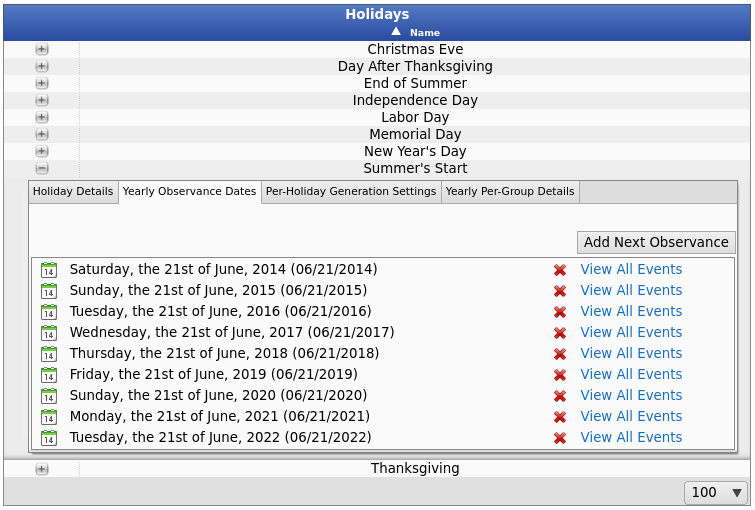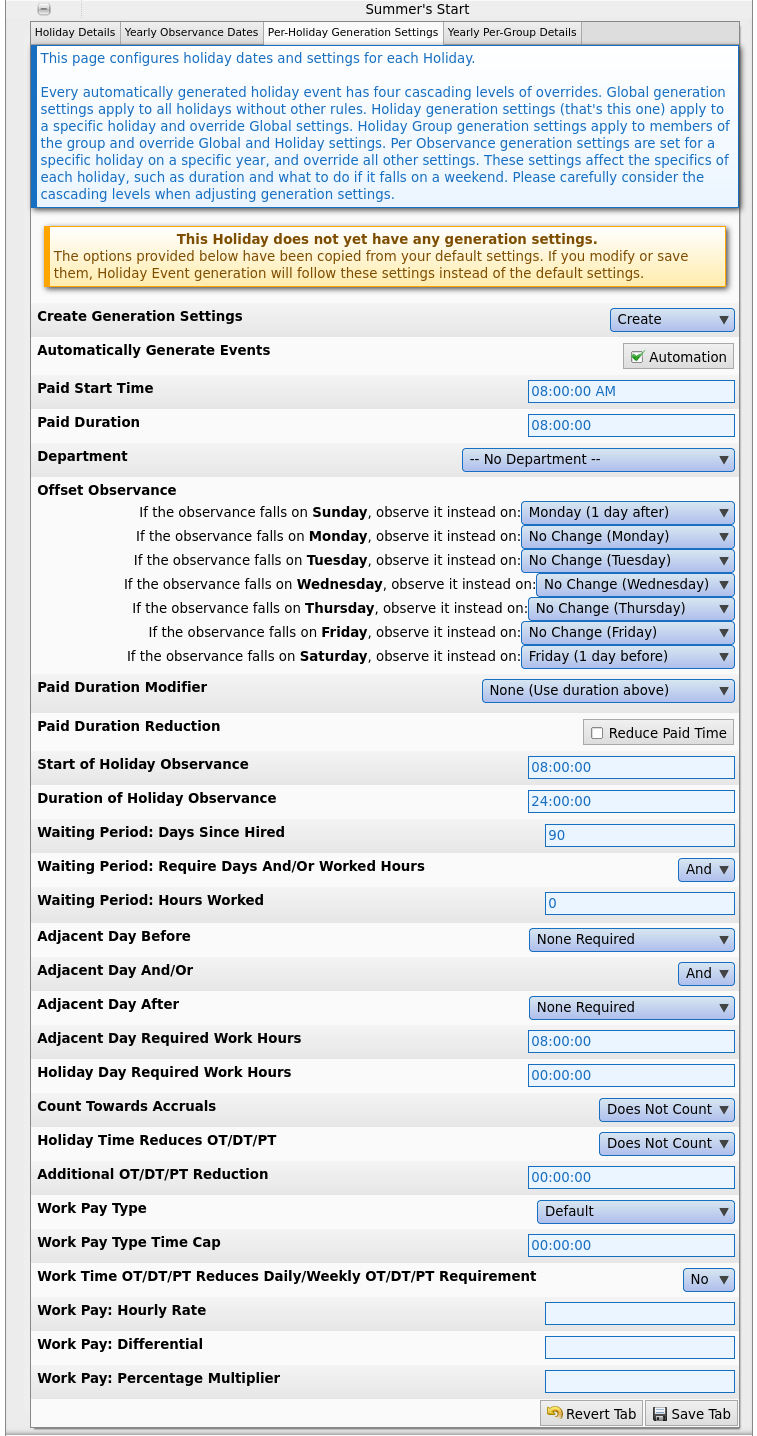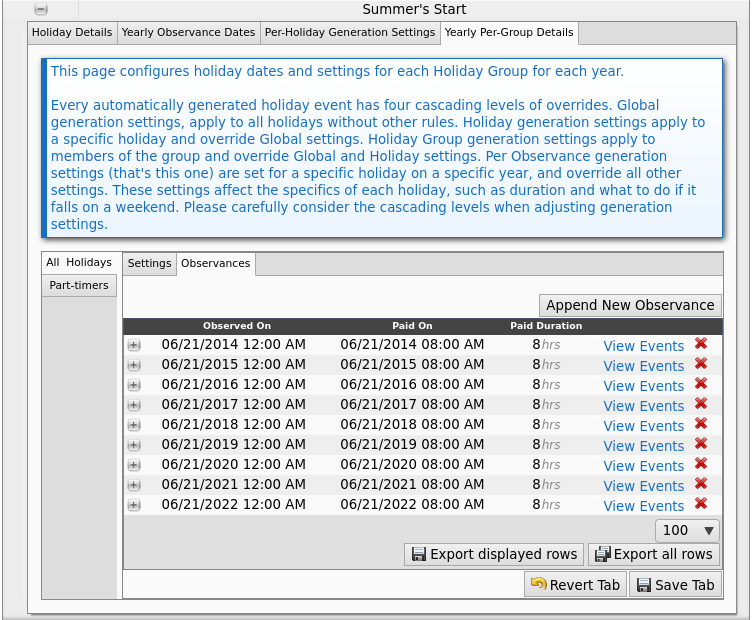
|
|
Applies to versions: 3.1, 3.2, 3.3, 4.0
Automatic Holidays
TimeIPS Automatic Holidays provide a way to quickly create recurring holidays.
Using the left pane Main Menu » Administration, click on: Holidays » Automatic Holidays
On a new system with no previous configuration, you will be presented with the following screen.

Clicking the link will take you to the Holiday Group Administration page, where a default group can be configured for your review. (See the Holiday Groups article for instructions.)
Add A NEW HOLIDAY
- Click the + (plus) sign on the far left to expand the "Add a New Holiday" panel.

- Fill in the information as prompted.
- Holiday Name: The name of this holiday.
- Holiday Paycode: A custom code that can be used for identifying payroll events for this holiday.
- Holiday Worked Paycode: A custom code that can be used for identifying worked time payroll events for this holiday.
- Observance Type: An "Automatic" holiday will follow the holiday's generation settings to automatically generate the holiday events each year. The "Not Automatic" holidays can be used for Manual holidays that should not automatically be created.
Select Automatic if this holiday is observed by everyone on the same day.
Select Not Automatic if this holiday happens at a different date for each employee.
- Observed By: How the Holiday Rules should determine the day this holiday is observed. You can always change the actual day that this holiday occurs on for any given year by modifying its entry in the Observance List below.
Select Calendar Date to simply set a specific month and day for this holiday, like "Jan 1st."
Select Observed Rule to set a rule, like "The fourth Thursday of November."
- Calendar Date: The exact calendar date of the year that this holiday is observed.
Note: the selector allows for changing the year, but only the month and day are saved.
- Common Holidays: Select 'show' to see a list of common holiday observances.
- Click the Add New Holiday button.
VIEW & EDIT HOLIDAYS
Once you have created a holiday, you can manage it's information and observances from the Holidays table.

- Click the + (plus) sign to the left of the Holiday Name to expand the window.
Holiday Details tab

- From the Holiday Details tab, you can edit the original information used to set up the Holiday. For a description of each, see the "Create a New Holiday" section above.
- Be sure to click the Save Tab button after making changes.
- Holidays can also be deleted here by clicking the Delete button.
Yearly Observance Dates tab
The observance dates listed on this tab are the standard dates for each year for this holiday. These dates are generated based on the rules set on the Holiday Details tab. Each Yearly Per-Group observance will be based on these dates. Normally all past years and one future year will be listed. You can force the creation of additional future years by clicking Add Next Observance.
Observance dates can be edited for each year to fit your needs. These can be calculated into the future as needed. If you don't pre-calculate them, they'll be added automatically as the next year's holiday date approaches.If changes are made to these dates, and Yearly Per-Group Observances already exist, you will be prompted to automatically update them, provided the date doesn't occur in a payrolled time period, or the date isn't moved into a payrolled time period.

Per-Holiday Generation Settings tab

Create Generation Settings: To create specific settings, set this option to "Create" and fill out the settings form.

- If Automatically Generate Events is checked, the Holiday Engine will automatically create future observances and events without the need for any human interaction.
- Paid Start Time: The time of day during the Holiday that it will be observed and paid. This is set to 8:00 AM by default.
- Paid Duration: The duration of time the holiday event will pay. This is set to 8 hours by default. The duration can also be an expression. Please see the Default Holiday Generation article.
- Department: Select the department that Holiday Events generated by these settings should be tracked against.
- Offset Observance: When an automatically generated holiday falls on a sepcified day of the week, you can configure TimeIPS to observe that holiday, instead, up to six days before or after that chosen day. For example, if Christmas Eve falls on a Saturday and Christmas Day falls on a Sunday, you can configure TimeIPS to have Christmas Eve occur one day before (on Friday), and Christmas Day to occur one day after (on Monday).
- Paid Duration Modifier: This option modifies the selected holiday pay duration in one of four ways.
- None: The paid amount is not modified. Employees will receive the holiday pay duration set above.
- Prorate 40H vs Sch Weekly Hours: Grants a percent of the holiday pay duration set above as a proportion of scheduled weekly hours to 40 hours. If an employee is scheduled for 30 hours of work and 8 hours of holiday pay is configured, the employee will receive 6 hours of holiday pay.
- In/Out Schedule Time: Grants the employee the amount of time scheduled for the day instead of the holiday pay duration set above. If an employee is scheduled for 6 hours the day of a holiday and 8 hours of holiday pay is configured, the employee will receive 6 hours of holiday pay.
- Default Job Coverage: Grants the employee the amount of time scheduled for their default job coverage on the scheduled day instead of the holiday pay duration set above.
- Paid Duration Reduction: Enable this option to reduce the duration of holiday hours paid by the amount of time worked or benefits used during the holiday observance range.
- Start of Holiday Observance: (Optional) Hours prior to holiday paid time to begin the holiday observance. The holiday observance is the "day" of the holiday. Used to figure the holiday start date and determine work that is "done on" the holiday for Work Pay Type, Work Pay, etc. settings below. In a typical configuration, set to 8 hours to match holiday pay that starts at 8am, so the holiday is one calendar day.
- Duration of Holiday Observance: (Optional) Duration of the holiday observance. Normally 24 hours. Sets the end point after which work will no longer be considered done on the holiday for the Work Pay Type, Work Pay, etc. settings below.
- Waiting Period: Days Since Hired: The number of days since an employee was hired before qualifying for a holiday. This is set to 90 days by default.
- Waiting Period: Require Days And/Or Worked Hours: Employees can either meet one of the two Waiting Period requirements, or both of them. Set to "And" to require both, and set to "Or" if meeting either will allow an employee to qualify for the holiday.
- Waiting Period: Hours Worked: The number of hours worked since the employee was hired, before being able to qualify for a holiday.
- Adjacent Day Before: To qualify for a holiday, an employee may be required to work a valid day before. This can be the preceeding Calendar Day, to closest preceeding Scheduled Day, or the closest Weekday in the case of weekend holidays. If the previous day is configured as a Holiday and the employee did not work the required amount of hours on that day, the day preceeding it will be used, and so on.
- Adjacent Day And/Or: Set to "And" if the employee must satisfy both the day before rules and the day after rules. Set to "Or" if the employee may earn the holiday by satisfying either rule.
- Adjacent Day After: To qualify for a holiday, an employee may be required to work a valid day after. This can be the following Calendar Day, to closest following Scheduled Day, or the closest Weekday in the case of weekend holidays. If the following day is configured as a Holiday and the employee did not work the required amount of hours on that day, the day after it will be used, and so on.
- Adjacent Day Required Work Hours: To qualify for a holiday, an employee must work this many hours on each configured adjacent day. If this is set to 0 hours, the Adjacent Day configurations will be ignored. This is set to 8 by default.
- Holiday Day Required Work Hours: To qualify for a holiday, an employee must work this many hours on each configured adjacent day. If this is set to 0 hours, the Adjacent Day configurations will be ignored. This is set to 8 by default.
- Count Towards Accruals: Set to "Counts" if the Holiday Pay Hours time for this holiday should be used to count as worked time for benefit accrual calculations.
Note: Holidays always count toward benefit tenure level calculations.
- Holiday Time Reduces OT/DT/PT: Select "Counts" if, in accordance with Canadian Labour Code, Part III, Division I, 169(3) as of Jan. 1 2007, employees getting this holiday should have "the hours of work of the employee in that week ... be reduced by the standard hours of work for each general holiday in that week." If holidays do not affect the hours an employee must work to get weekly overtime, choose "Does Not Count."
- Additional OT/DT/PT Reduction: In addition to or instead of the previous option to allow Holiday hours to reduce weekly Overtime requirements, holidays can also be configured with an additional arbitrary number of hours that are subtracted from each employee's weekly Overtime requirement. For example, if a holiday event is 8 hours long, the holiday event is set to reduce Overtime requirements, and this option is also set to 8 hours then the weekly Overtime requirement would be reduced by 16 hours from possibly 40 to 24.
- Work Pay Type: Select "Over Time" if, in accordance with Canada Labour Code, Part III, 202 (1) as of Jan. 1, 2007, employees following this Overtime Policy should have all hours worked on the same calendar day as a holiday treated as overtime. Select "Double Time" if all hours worked during the holiday should be treated as doubletime. Note: If time on holiday qualifies for a higher paytype because of other rules, it will be promoted. If time on the holiday has a per-job or per-event setting, this value will be overridden.
- Work Pay Type Time Cap: If work pay type is not set to default then this option can limit the amount of time that is promoted to a different pay type.
- Work Time OT/DT/PT Reduces Daily/Weekly OT/DT/PT Requirement: Select "Yes" if, when employees work on holidays and the work pay type setting above is OT/DT/PT, the weekly hours required to reach OT/DT/PT should be reduced as well. For example, an employee works 40 hours in a week with 8 hours occurring during this holiday. With this option set to "No" the employee would not earn weekly overtime until 48 hours total (when the weekly ST hours worked during non-holiday periods reach 40). With this option set to "Yes" the employee would begin earning weekly overtime at 40 hours total (when weekly ST hours worked during non-holiday periods reach 32).
Unless the option for Work Pay Type is something other than Default this option is ignored.
- Work Pay: Hourly Rate: For work done in the Observed Range, pay this hourly rate.
- Work Pay: Differential: For work done in the Observed Range, add this differential to the hourly rate.
- Work Pay: Percentage Multiplier: For work done in the Observed Range, multiply hourly pay by this percentage.
- Delete Setting: Click the Delete button to remove this setting. This only affects the custom settings for this combination of holiday and holiday group. Holiday event generation will follow the more general rules that remain.
Yearly Per-Group Details tab
If you have not yet set up and automated generation settings, the Yearly Per-Group Details tab » Settings will display with a warning: "You do not currently have any settings configured. Any holiday events created will have 8 hours set for the duration." Creating specific settings is optional, and not required for automatic holiday generation to work.

Observances

- Clicking Append New Observance will automatically create the next observance for this group.
- The details for each observance can be managed individually by clicking on the + (plus) sign to expand the window.
- Be sure to click the Save Tab button after making changes.
- To delete an individual observance, click the red X to the right of it.
|

 Information
Information Sales
Sales Support
Support







